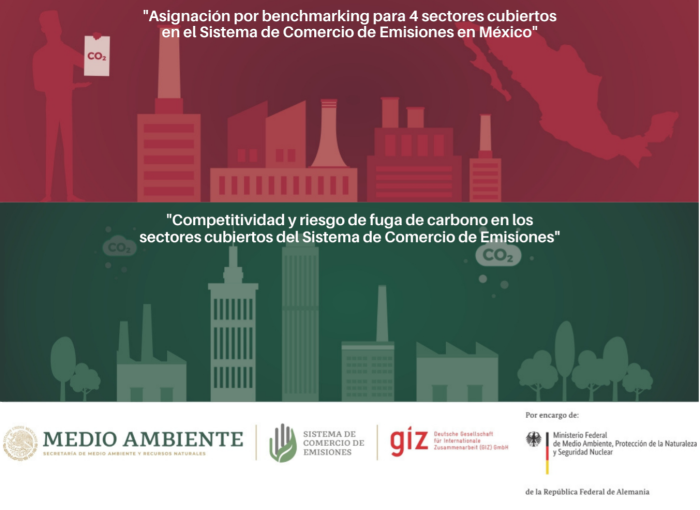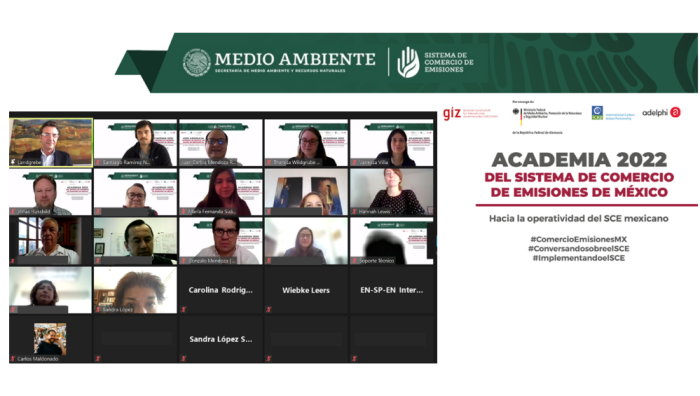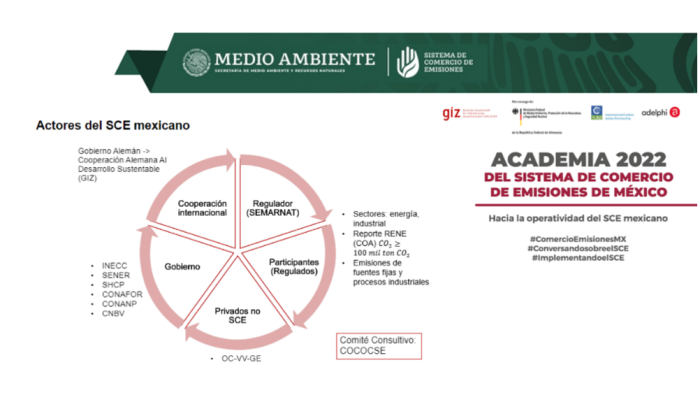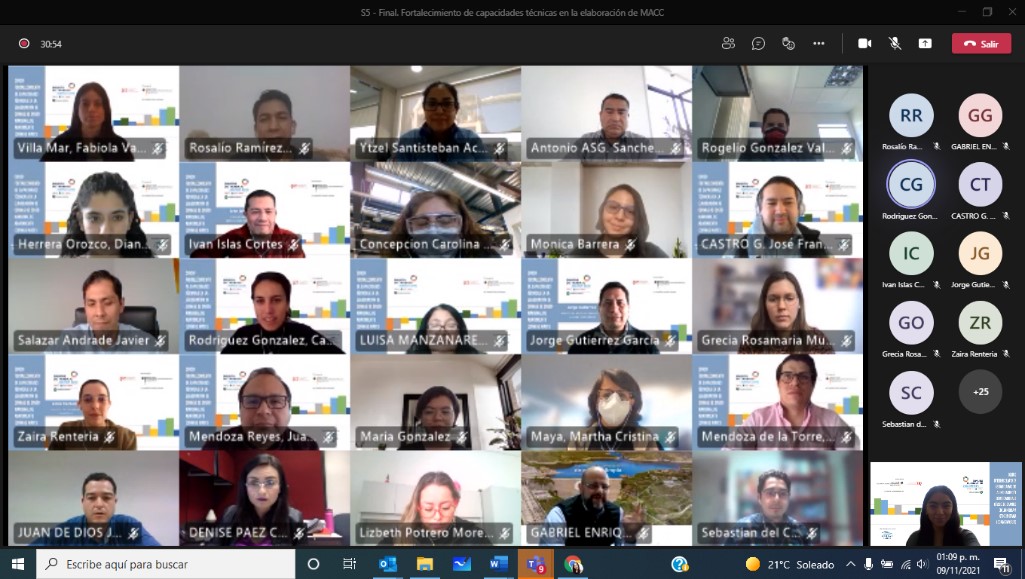The GIZ project “Preparation of an ETS in Mexico” (SiCEM) provides support to the Ministry of Environment and Natural Resources (SEMARNAT) in the continuous development of capacity-building activities for relevant actors and decision-makers from public and private sectors. The project, which began on January 1, 2020, is carried out within the framework of the Emissions Trading System (ETS) Test Program in Mexico.
In this context, the 2020 ETS Academy was held for the second consecutive year. On this occasion, it was successfully carried out virtually, and focused on the implementation aspects of the Test Program. The course was convened by SEMARNAT and developed with the support of the World Bank’s Partnership for Market Readiness (PMR), the International Carbon Action Partnership (ICAP) and GIZ Mexico.
Between August 18 and September 10, productive space for exchange and networking was generated among around 60 course participants. During these four weeks, learning was strengthened with presentations of the lessons learned, merits and challenges in the implementation of an ETS by national and international experts (China, Quebec, California, European Union, etc.), as well as the use of innovative digital tools and images that captured the key points discussed during the sessions.
Finally, there were two sessions open to the public, attended by Mr. James Grabert, Director of Mitigation of the United Nations Framework Convention for Climate Change (UNFCCC), as well as an exchange session between Latin American countries on carbon price instruments.

Photographic Archive 2020 ETS Academy © GIZ
Week 1. ETS Architecture, Pilots from Mexico and the World
The first week set the stage for subsequent sessions, introducing the concept of carbon pricing instruments and the opportunities presented by the ETS in order to meet the NDC mitigation climate targets based on the Paris Agreement. Although the international experience has shown that it is a cost-effective instrument, its effective implementation requires clear regulatory frameworks, a national policy that responds to international commitments, and close communication with the actors involved in the process.
Jurisdictions such as China, Quebec, and Spain (as part of the European ETS) shared their ETS experiences in the early phases. They stressed the importance of having a strong regulatory and political framework, creating opportunities for dialogue with the regulated sectors and ensuring the quality and robustness of emissions data. In recent years, Mexico has implemented a legal and institutional framework on the matter based on the reform of the General Law on Climate Change in 2018 and the publication of the Agreement establishing the preliminary bases of the ETS Test Program, in which the figure of the Advisory Committee is also created as a space for dialogue and feedback. It also has a robust MRV framework, reflected in the National Emissions Registry (RENE).
Week 2. Allocation and Market Dynamics. What are the Options?
During the second week, the methods to allocate Emission Allowances (DEM) were discussed. Each jurisdiction chose a method (or combination of methods) to use based on national priorities and ETS objectives, among which the following stand out: incentivizing abatement measures, increasing revenue at the government level, protecting the competitiveness of regulated facilities or manage a gradual transition to an ETS. In the case of Mexico, the Trial Program will start a free scheme based on historical emissions per installation in order to facilitate the transition to the Formal Phase of the ETS; later on, the implementation of a percentage of allocations through auctions is envisaged.
Once DEMs are assigned, they can be traded on the secondary market. In the sessions, actors involved in DEM trading in the European ETS covered the different alternatives that exist for this trade, such as exchanges or stock exchanges, or bilaterally through a mechanism known as over-the-counter, as well as looking at the relevant difference that exists between regulated carbon markets (a public policy instrument with a defined legal framework and jurisdiction to reduce GHG emissions) and voluntary ones (a decentralized initiative to promote the reduction of emissions and facilitate the participation of more actors in mitigation activities).

Photographic Archive 2020 ETS Academy © GIZ
Week 3. Monitoring, Reporting and Verification Systems (MRV): ETS Challenges and Successes
An effective ETS requires a robust MRV scheme, as this allows designing the top of the ETS and making a better DEM allocation. Also, it ensures environmental integrity and enables compliance monitoring of the covered sectors. It was highlighted that it is crucial to incentivize compliance in an SCE, since otherwise, there is a risk of distorting competition between regulated entities. Jurisdictions such as California, Germany, the Netherlands, and China, shared the mechanisms used to strengthen compliance in their jurisdictions, such as the involvement of the regulated from the early stages of the process so that they are well aware of their obligation, the constant and proactive communication of obligations, listening to feedback, even administrative and economic sanctions.
Week 4. ETS Social and Environmental Benefits and Progress in Latin America. Where are we, and where are we going as a region?
During the last week, the 2020 ETS Academy addressed two topics: offset mechanisms and carbon price instruments in Latin America.
Regarding the first, the ETS includes mechanisms to encourage mitigation actions in non-regulated sectors under the offsets scheme. These contribute to the sustainable development of other sectors and actors indirectly linked to the ETS. Similarly, they allow cost reduction by improving the efficiency of the ETS. With a view to the Operational Phase, a global overview of these mechanisms was presented, as well as an exploration of the possibility of generating offsets for sectors such as forestry, livestock and agriculture, and transportation, within the Mexican context.
On the closing, the 2020 ETS Academy culminated with the exchange of experiences in the Latin American region. The participants had the opportunity to learn about the different advances in the area based on carbon prices. In this regard, countries such as Chile, Peru, and Colombia have implemented a tax on carbon or fossil fuels, while Brazil is analyzing the most cost-effective instrument for the country. Mexico is positioned as the first country in the region to have both a carbon tax and an ETS, so it will be of great interest to learn about their valuable experiences during the design of the ETS and the implementation of the Test Program.

Participants and speakers at the 2020 ETS Academy © GIZ
For more information on this topic, please contact us at: Comercio.Emisiones-MX@giz.de










